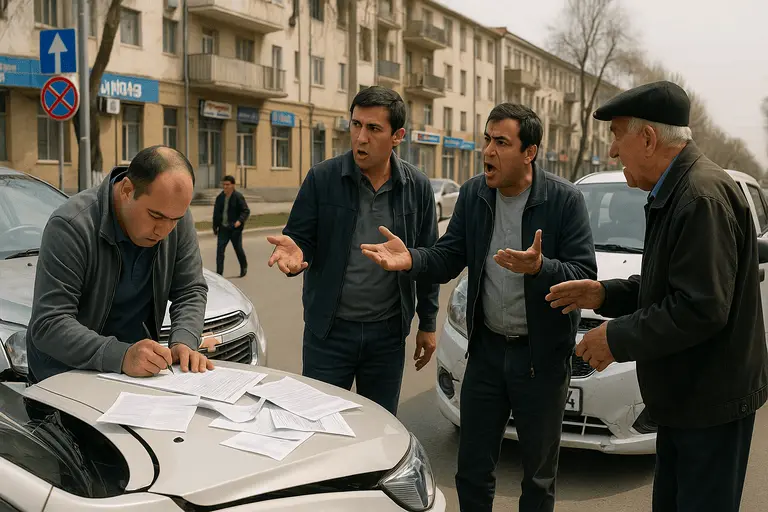
Georgia Travel Insurance 2026: Avoid the 300 GEL Border Fine
From 2026, travel insurance for Georgia becomes mandatory: without a policy you risk a 300 GEL fine (~1.3M UZS). Learn how to buy an affordable policy online

The Europrotocol significantly simplifies the procedure for documenting road traffic accidents, but incorrect completion of the documents can lead to serious problems when claiming insurance compensation. According to insurance companies, about 30% of Europrotocol claims are rejected due to documentation errors. Let’s look at the most common mistakes and how to avoid them.
One of the most critical mistakes is insufficient documentation of the accident scene. Many drivers take only a few photos of the vehicle damage and forget to capture the overall picture of the incident. This can result in the insurance company denying the claim due to lack of evidence.
Proper photo documentation should include at least 10–15 pictures from different angles. It is essential to photograph the general scene, showing the positions of the vehicles in relation to road markings, traffic signs, and other reference points. Each individual damage must be captured in close-up, along with license plates of both cars, participants’ documents, and odometer readings.
Special attention should be paid to braking marks, broken glass, and vehicle parts on the road. These details can be crucial when determining the circumstances of the accident. It’s also important to show the surrounding traffic environment—traffic lights, signs, road surface conditions.
Real example: A driver completed the Europrotocol after a collision at an intersection but forgot to photograph the working traffic light. Later, the other party claimed they had a green light, and without photo evidence, it was impossible to prove otherwise. The insurance company denied compensation due to insufficient documentation.
The accident diagram is one of the key elements of the Europrotocol, but many drivers fill it out sloppily or inaccurately. A poorly drawn diagram can completely change the perception of the incident and influence who is deemed at fault.
When drawing the diagram, you must accurately show the positions of the vehicles at the time of the collision, their directions of travel, road markings, and signs. Include street names, building numbers, and distances to nearby landmarks. All elements must be labeled and understandable to third parties.
A common mistake is depicting cars as simple rectangles without indicating their orientation. It’s important to show which parts of the vehicles were involved in the collision and the angle at which they approached each other. Arrows should be used to show the trajectory of each vehicle up to the point of contact.
Another frequent issue is that the diagram does not match the photos taken at the scene. Insurance adjusters will always compare these details, and any inconsistencies may lead to further investigation or denial of compensation.
The Europrotocol can only be used if both drivers fully agree on the circumstances of the accident. However, in practice, drivers often sign the documents without verifying that their statements match each other’s.
Before signing the Europrotocol, both parties must carefully verify all details: the description of the accident, the diagram, and the indication of fault. If there are any discrepancies, even minor ones, it is better to call the traffic police (GAI) for official documentation.
Typical scenario: Two cars collide at an intersection. The first driver writes that they were going straight on a green light, and the second says they were turning left. However, the second driver also claims to have had a green light. This contradiction renders the Europrotocol invalid.
It’s important to remember that the Europrotocol implies complete agreement between the parties not only on the facts but also on who is at fault. If there is any doubt, it is better to wait for the police than to settle things later in court.
Many drivers are unaware that strict deadlines exist for submitting documents after completing the Europrotocol. Missing these deadlines may lead to claim rejection or significant delays in receiving payment.
The injured party must submit the documents to the insurer of the at-fault driver within 5 working days from the date of the accident. The at-fault driver must also notify their insurer within the same timeframe. Note: the countdown starts from the date of the accident, not when the driver learns they need to submit the documents.
The required documents include:
The completed Europrotocol;
Copies of all participants’ documents;
Photos of the accident scene;
An official accident report (if obtained).
All documents must be submitted at the same time — sending additional documents later may be considered a violation of the rules.
Pro tip: Don’t wait until the last day. It’s best to contact the insurance company the next day after the accident while everything is still fresh in your memory and you have time to fix any issues.
The most serious mistake is trying to use the Europrotocol for an accident that does not meet the criteria for simplified documentation. This can lead not only to denied compensation but also to administrative or criminal liability.
You cannot use the Europrotocol if:
More than two vehicles were involved;
There are injured people;
The damage exceeds the established limit;
Road infrastructure is damaged;
One of the drivers is intoxicated or does not have a valid OSAGO policy.
You should also be careful when assessing the damage amount. Many drivers underestimate repair costs—especially for modern vehicles with expensive parts and complex electronics. If you’re unsure, it’s safer to call the police.
Real example: Drivers assumed their damages were minor and filled out the Europrotocol. However, a detailed inspection revealed that the vehicle’s safety system was damaged, and the repair costs exceeded the Europrotocol’s limit by three times. As a result, the injured driver did not receive full compensation.
To fill out the Europrotocol correctly, follow these simple rules:
Always keep several blank accident forms in your car;
Make sure your phone or camera is charged and ready for use;
Study how to fill out the Europrotocol in advance — it’s hard to focus on instructions during a stressful moment.
If you have any doubts — call the traffic police. The time spent on official procedures will pay off in the form of confidence and guaranteed insurance compensation.
You can find detailed information on how to fill out the Europrotocol and avoid common mistakes on the official Europrotocol page, which contains current guidelines and practical advice for drivers in Uzbekistan.

From 2026, travel insurance for Georgia becomes mandatory: without a policy you risk a 300 GEL fine (~1.3M UZS). Learn how to buy an affordable policy online

Euroasia Insurance hosts a 10-day master class on underwriting led by an international expert from England. Learn about implementing global best practices in risk assessment and insurance claims management in Uzbekistan.

The first winner of EUROASIA Winter Giveaway announced! Participate until Feb 6, 2026 and win iPhone 17 Pro Max, KASKO and other prizes via the app.

Notice of shareholder meeting on December 24, 2025. Auto insurance, travel insurance in Uzbekistan from EUROASIA INSURANCE.